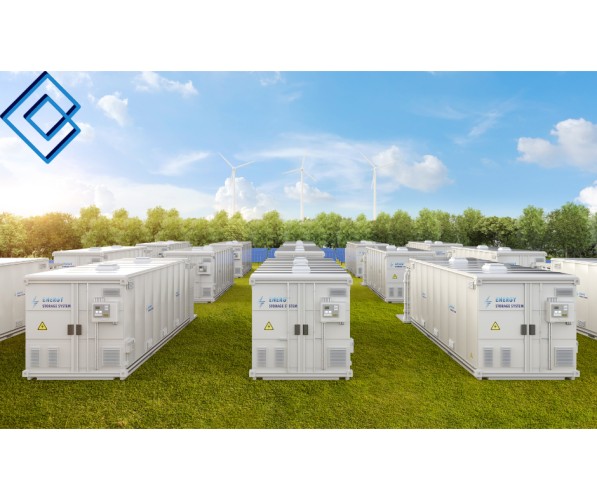Battery Energy Storage Systems are Safe and Increase Grid Reliability
 | Molly Vagle, Communications Associate, Siting |

 | Molly Vagle, Communications Associate, Siting |
Energy storage is the process of capturing energy when it's produced so it can be used at a later time when it's needed most. Battery Energy Storage Systems (BESS) are a type of energy storage that uses a group of batteries to store electricity. BESS is an emerging technology that enables clean energy resources like wind and solar to be stored and released when energy demand is at its highest. As increasing energy demand threatens energy reliability and affordability, energy storage can reduce costs and support a flexible, reliable grid by storing excess power that would otherwise be wasted and providing that power back to the grid when it's needed most.
There are many types of energy storage, such as pumped-hydro, flywheels, compressed-air, hydrogen, and thermal energy, with battery being the most pursued option. Lithium-ion batteries are the ones we are most familiar with- these batteries are also used in cell phones and electric cars. Lithium-ion batteries are used at large- scale battery storage plants to save large amounts of energy that otherwise would have gone unused.
Energy storage facilities are safe by design. Facilities comply with the nation's most rigorous fire standards from the very beginning of developing battery cells, manufacturing, all the way through project operations. In addition to these codes and regulations, risk mitigation is ensured with best practices, proper design and operations, and close coordination with local fire departments.
Batteries have been, and continue to be, an essential part of our life. These technologies have well-established safety features and rigorous codes and standards that must be met to be permitted to operate. These projects are regulated, held to national safety standards, and must comply with National Fire Protection Standards that are frequently updated, along with state and local governments ensuring compliance with current standards and other regulations.
Some of the best practices for keeping BESS projects safe include:
- Pre-installation Standards and Testing. All modern batteries are designed to pass standard safety testing prior to operation. Safety standards and performance tests help to ensure the technologies deployed in BESS uniformly comply with the highest global safety standards.
- Proper Temperature Management. All energy storage projects have thermal management systems, like fans, ventilation, and heating and cooling equipment to maintain safe operating temperatures for the batteries.
- Sensors that Regulate Temperature. All projects are equipped with sensors that track battery temperatures and enable the facility to turn off batteries if they get too hot or cold. A Battery Management System manages the charging and discharging of batteries.
- Safety Equipment. BESS facilities include equipment and systems designed to detect and suppress fires, vent gases, and incorporate fire-proof barriers.
- System and Component Certification. OSHA's Nationally Recognized Testing Laboratories provide screening, testing, and evaluation for BESS technologies and components.
- 24/7 Monitoring by Trained Personnel. BESS facilities are monitored 24/7 by trained personnel prepared to maintain safety and respond to emergency events
- Emergency Response Plans. All BESS operators develop and maintain emergency plans to ensure that if there were an event it is handled safely and according to best practices Developers work with local fire departments and first responders for training and to share information on risks, response plans, and safety measures.
- First Responder Pre-Planning and Training. Operators develop emergency response plans based on national best practices that are customized for each facility.
- Pre-Incident Planning. Used by first responders in managing emergencies.
- Incident Response. The incident command system should be established immediately on arrival. Gloves on, scene safe (Personal Protective Equipment (PPE).
What Are the Benefits of Energy Storage?
One of the greatest strengths of energy storage is its ability to provide reliability and resiliency of the electric grid. Batteries ensure a consistent, reliable stream of power even when unexpected fluctuations in energy supply or demand occur. If an extreme weather event threatens to cause a blackout, storage can kick online and keep the lights on.
Additionally, energy storage provides cost savings to consumers. When there is an excess of clean, low-cost clean energy available, or low demand on the grid, the cost of energy is significantly lower than it is during peak times of demand or during energy shortages. Provided the appropriate market rules are in place, energy storage facilities can capture this low-cost energy and store it. Then, instead of paying a higher price to generate energy from resources that have additional fuel costs, the grid operator can dispatch low-cost energy from storage facilities, which helps keep costs low for consumers.
Energy storage also reduces the amount of energy that is wasted. When there are certain conditions, such as periods of high supply and low demand or transmission congestion, there can be an over-production of energy. In times of over-production, wind and solar projects that could be producing low-cost energy are temporarily shut down – a process called "curtailment." Energy storage allows us to avoid curtailment, instead capturing this excess and storing it until it's needed.
Battery energy storage systems, and energy storage systems in general, are built with safety in mind to increase the reliability of our electrical grid and enable more clean, affordable energy while reducing energy waste by capturing and releasing energy when and where it is needed most. Energy storage captures today's energy to ensure reliability tomorrow.